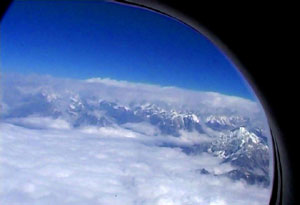 'I believe any trip in search of wildlife can be coupled with physical activity and elements of cultural diversity to form a thrilling opportunity ' 'I believe any trip in search of wildlife can be coupled with physical activity and elements of cultural diversity to form a thrilling opportunity '
John H.Eickert |
At certain times of the year and depending on where you are, India can become gripped in heat. The heat moves over the land as if a giant wave. Not a wave of water mind you, but a wave of heat. Fortunately, as with all waves, finally
the wave retreats leaving everyone thankful for the rain, but mindful that the wave will come again. There are places in India where one can rise up out of the heat, just as high ground can protect from a great wave. To stand at the view point above Sandakphu
or much of the Singalila Ridge is to be at such a point. Below you the land, the country can be awash under an intense heat wave, while before you and beyond as far as the eye can see extend green mountain after green mountain in an unbroken vista reaching
the glacial covered Himal. This is the reward from the trek to Singalila Ridge.
 |
The 160 kilometer trek can start from the small village of Manebhanjang at 2134 meters in elevation and 26 kilometers from Darjiling. Along the route, there are trekkers-shelters as well as private trekking lodges. It is also possible
to camp, but due to the nature of the hike, porters would be required to help with the necessary equipment, making the entire adventure more costly and complicated than need be. Personally, I enjoy camping, but here it is better to enjoy the lodges and numerous
tea houses for overnight accommodations and dining.
Leaving Manebhanjang the trekker ascends up to Meghma and then Gairibas. Some of this portion of the trek is along a jeep road. Past Gairibas the track climbs again to the hill town of Sandakphu at 3636 meters. From here, the track remains
high on Singalila Ridge for several days passing the village of Sabarkum and ending at Phalut. The elevation at Phalut is 3600 meters and is perhaps 25 kilometers from Sandakphu. A joyful two days ‘walking in the sky!’
As always, you must descend and the walk down to Rimbick at 2287 meters and then the jeep ride back to Darjiling go quickly. This entire trek is popular, not the trek for those needing solitude, but a wonderful opportunity to meet new
friends. Because of the popularity, there is little wildlife, though the magnolias and rhododendron forests support a wide variety of birdlife. Actually, those who enjoy ‘birding’ may wish to follow this trek in winter as the Singalila National Park shelters
a sizeable migratory bird population at that time of year. Whenever you go be sure and plan your transportation to Manebhanjang and from Rimbick, well in advance.
Waves are not only formed by water. Like water, one can rise above a wave of heat. What better reason to walk the Singalila Ridge? I hope each of you can take the time to do this trek, and of course, when you take the time, take your
time. Cheers.
( Photo by Susan Sharma: View of the Himalayan range from a plane over Nepal )
Note: Singalila National Park is at the extreme northwest of West Bengal and forms the border with Nepal. It is a high altitude protected forest.
Visit http://www.numbum.net or call NumBum Adventurers at 406-777-2228